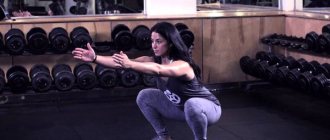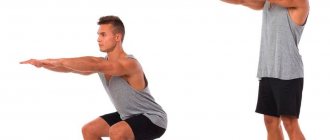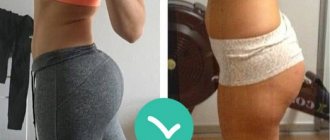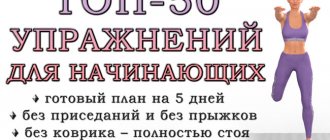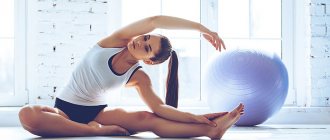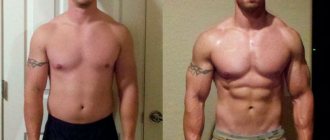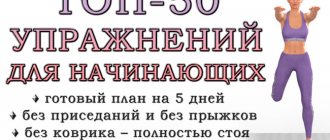Squats are one of the most common movements we do throughout the day. Toned buttocks and strong legs aren't the only benefits you'll get from this exercise.
Various variations of squats are used in the rehabilitation of athletes after injuries, and doctors recommend them to improve the reproductive function of men and women. The list of advantages can be continued endlessly.
Every day we squat dozens of times without even knowing it. It would seem that the legs and buttocks should become more voluminous and more prominent, but this does not happen.
Egor Fukalov
fitness trainer
For squats to become effective, it is important to consider two points: a high-quality load so that muscles grow, and the correct technique.
How to do squats correctly:
- Stand up straight with your knees straight and your hips slightly wider than your shoulders.
- Direct your gaze forward with a neutral head position.
- Bring your chest forward and up, and bring your shoulder blades together, as if you are squeezing something between them.
- Pull your shoulders back a little.
- Keep your torso in a straight position. The spine must be kept rigid throughout the entire movement.
5 Best Squats for Toned Butts
- The hips are level.
- Turn your feet 45-30 degrees. It is this positioning of the legs that will allow the knees to move in the direction of the toes. Press your heels firmly into the ground.
- Bend at the shins, knees and pelvis at the same time. The knees are on the same line. Make sure your knees don't fall inward.
- Lower yourself slowly with a straight back to a 90-degree angle at the knee joint.
- From the bottom of the squat, push yourself up with a powerful movement, straining your back and abs.
- Lock yourself at the top point with your legs straight.
Photo: unsplash.com/@weareambitious
Reduces the risk of sports injuries
If you are planning to sign up for a gym and regularly visit it, then you need to remember that the intense physical activity that your body will be subjected to there can negatively affect the condition of the joints and ligaments. Doing squats every day will help reduce the risk of sports injuries by making the muscles in your lower body more prepared to handle this kind of stress.
Squats are an excellent way to prevent sports injuries. By performing 100 or more squats daily, you strengthen your abs, ankles, knees, back and leg muscles, and improve the condition of your joints and ligaments.
What to look for:
- Squat depth. Choose the depth to suit your goals and objectives. Unless you have any limitations such as knee or spinal injuries, do full squats until your thighs are parallel to the floor. This is necessary so that the muscles of the back of the thigh and buttocks receive a high-quality load.
- Squat method. You can squat effectively both with your own weight and with additional weights. There are also several types of squats: classic, sumo, plie, etc.
- Fatigue and technique. Exhaustion negatively affects movement technique. Make squats the first exercise in your workout, or don't put too much stress on your lower body before doing them.
- Movement speed. Lower yourself slowly and under control, about 2-3 seconds. Rise explosively for about 1 second.
Strengthens different muscle groups
Do you think that during squats only the muscles of the thighs and buttocks work? You are wrong! If you squat 100 times every day, you will pump up your calf, lumbar, abdominal, neck and upper back muscles!
Squats not only strengthen muscles, but also have a positive effect on gaining muscle mass. Those people who are dissatisfied with their appearance and want to become the owners of a more prominent and proportional body, but do not have the opportunity to visit the gym or spend money on having a professional trainer develop a training program for them, should definitely pay attention to such a simple and easy exercise like doing squats every day.
Take a little time to do this exercise, and after a while you will be surprised to notice that your muscles have become stronger and your body has acquired a more attractive and presentable appearance! One and a half to two months after the start of classes, the external and internal muscles of the thighs will noticeably pump up and tighten, men’s legs will become more prominent, and women’s hips will acquire a more rounded and clear line.
Monthly squat plan
In order to achieve the maximum effect from squats, there must be dynamics in daily exercises. You need to increase the number of repetitions each time.
We offer a universal monthly plan, thanks to which you will definitely get your legs in shape and tighten your buttocks.
| Week 1 | Mon | W | Wed | Thu | Fri | Sat | Sun |
| 1 approach | 10 times | Rest | 10 times | Rest | 10 times | Rest | 10 times |
| 2 approaches | 10 times | Rest | 10 times | Rest | 20 times | Rest | 10 times |
| 3 approaches | 20 times | Rest | 15 times | Rest | 20 times | Rest | 20 times |
| 4 approaches | 20 times | Rest | 15 times | Rest | 20 times | Rest | 20 times |
| 5 approaches | 10 times | Rest | 10 times | Rest | 10 times | Rest | 10 times |
| Total: | 70 times | 60 times | 80 times | 70 times | |||
| Week 2 | Mon | W | Wed | Thu | Fri | Sat | Sun |
| 1 approach | 15 times | Rest | 10 times | Rest | 15 times | Rest | 15 times |
| 2 approaches | 20 times | Rest | 20 times | Rest | 20 times | Rest | 20 times |
| 3 approaches | 20 times | Rest | 20 times | Rest | 30 times | Rest | 20 times |
| 4 approaches | 20 times | Rest | 20 times | Rest | 20 times | Rest | 20 times |
| 5 approaches | 15 times | Rest | 10 times | Rest | 15 times | Rest | 15 times |
| Total: | 90 times | 80 times | 100 times | 90 times | |||
| Week 3 | Mon | W | Wed | Thu | Fri | Sat | Sun |
| 1 approach | 20 times | Rest | 15 times | Rest | 20 times | Rest | 20 times |
| 2 approaches | 20 times | Rest | 20 times | Rest | 25 times | Rest | 20 times |
| 3 approaches | 30 times | Rest | 30 times | Rest | 30 times | Rest | 30 times |
| 4 approaches | 20 times | Rest | 20 times | Rest | 25 times | Rest | 20 times |
| 5 approaches | 20 times | Rest | 15 times | Rest | 20 times | Rest | 20 times |
| Total: | 110 times | 100 times | 120 times | 110 times | |||
| Week 4 | Mon | W | Wed | Thu | Fri | Sat | Sun |
| 1 approach | 20 times | Rest | 20 times | Rest | 25 times | Rest | 20 times |
| 2 approaches | 30 times | Rest | 25 times | Rest | 30 times | Rest | 30 times |
| 3 approaches | 30 times | Rest | 30 times | Rest | 30 times | Rest | 30 times |
| 4 approaches | 30 times | Rest | 25 times | Rest | 30 times | Rest | 30 times |
| 5 approaches | 20 times | Rest | 20 times | Rest | 25 times | Rest | 20 times |
| Total: | 130 times | 120 times | 140 times | 130 times |
Don't forget that sports not only makes you more beautiful, but also raises your self-esteem. Now you know what to do. Hurry up and start your workout!
Train your heart: squats instead of running
Squats instead of running
The human body is able to tolerate any treatment of itself - compensatory functions will maintain the normal functioning of all organs, regardless of whether you are taking care of your health or, conversely, abusing bad habits. However, this only occurs at a young age, up to about 30 years of age. Further, your well-being will largely depend only on your lifestyle. It is possible to maintain normal cardiovascular system, central nervous system and other organs by periodic jogging or just walking. Regular squats are also a good alternative. It turns out that 100 squats replace 1 km of leisurely running.
Here is an article dedicated to this topic.
Physical education and sports A thousand squats? (Heinrich EPP) “I took care of my health very late when I had already reached retirement age. I started with running. I was able to run the first kilometer in three steps, gasping for air with my mouth open. It was in autumn. The colder it got outside, the more often I caught a cold while jogging. I thought about it and decided to limit myself to squats for the first time in order to give my heart a rhythmic load. The first time I managed to sit down only 10 times; shortness of breath was the limit. I trained hard and two months later I got to 25 squats. I was proud of my achievement and shared my joy with one employee. He did not share my enthusiasm and said that he could easily sit down 50 times in a row. A month and a half later, I also reached 50 squats. On the same day, I told our young trainee about this. “Just think,” he replied. “In our dorm, one guy did 1000 squats on a dare!”
Squats
It seemed to me that there was really nothing to brag about, that every normal person should be able to squat at least 1000 times in a row. This attitude gave me strength. It took me 135 days to reach my first hundred squats. A week later, I completed 200 squats. My squat pace was 5 minutes per hundred. After six months of such training, I became so strong that on average I added 100 squats per week. The next day, after 1000 squats, I jumped on the treadmill and easily ran 8 kilometers. The pulse rose to 170 beats per minute, and there was no sign of shortness of breath. If we proceed from the formula according to which the extremely high heart rate should be equal to 220 beats minus age, then in six months of squats I became 12 years younger (220-170 = 50 years, and I was 62 at the time). Three years later (in 1975), after 900 squats at an increased pace, the pulse rose to 182 beats per minute, this is the level of the critical pulse of a 38-year-old healthy person, and there was no shortness of breath. A year later, after 800 squats at a high tempo, my pulse rose to 194 beats per minute: I looked for shortness of breath, but did not find it, although I raised my heart rate to the level of the critical pulse of a 26-year-old healthy person. Until 1979, I trained my heart and myself in general, sometimes by running, sometimes by squats, and became convinced that 100 squats and one kilometer of running in the same time were approximately equivalent. In 1980, I conducted a series of experiments: after a certain gymnastics complex that raised my heart rate to 78 beats per minute, I did a given number of squats and counted my heart rate daily - one value. The table offered here consists of three columns, built at a pace of 6 minutes, 5 minutes, 4 minutes per 100 squats.
Squats, bench press. Time, min. Pulse, bpm/mmm Squats, coll. Time, I think. Pulse, beats/min Squats, no. Time, min. Pulse BP-min. 100 6 104 100 5 116 100 4 1 40 200 120 | 200 8 140 300 180 300 12 140 400 242 400 16 140 500 302 500 20 150 600 366 600 24 150 700 420 700 28 150 800 480 800 32 160
The table shows how finely the heart rate level is regulated by squats. Of course, running in the lap of nature is more pleasant than doing squats at home in an apartment or on the balcony, but organizing squats is easier, especially if there is no free time. You need to exercise your heart every day, at least five times a week. And squats can be organized in any cramped space. 10 minutes of gymnastics and two to three hundred squats is already a guarantee for thirty-year-olds against physical inactivity.
My goal is to do as much work as possible with each squat, to involve as many muscles and joints as possible, to develop, firstly, endurance, secondly, flexibility, and thirdly, strength. You can start with squats and table presses: hands on the edge of the table, feet a meter from the table, lean forward as deeply as possible, do push-ups and squats - this option weakly stimulates the heart, it is for the poorly prepared. When squatting, throwing your arms forward is good for your back; throwing your arms up is training the vestibular apparatus; squatting to reach the floor with your hands in front of you, as far away from you as possible - this is flexibility training. Plus, of course, developing endurance. You can choose any option or combine them, but you need to know in advance how much your heart rate will rise. This comes with experience, thanks to constant study of your heart, the time of squats is gradually increased to 30 minutes. Each person should choose the nature of squats, technique of execution, number of movements and tempo for themselves in accordance with their capabilities and the needs of the body. There can be no pattern here. Until the end of the 70s, I stimulated the heart only for my own pleasure. Then I decided that my experience might be useful to others. At the end of 1981, the newspaper “Soviet Siberia” published my article. Based on this article, Elena Konstantinovna Safonova, born in 1905, was the first to find me. She was wondering if she could do squats if she had asthma and was 77 years old. We agreed that she would start with five squats while holding the back of a chair. Elena. Konstantinovna raised the load to 100 squats in three and a half months. Asthma became easier, and radiculitis, her longtime enemy, subsided. Her sister Vera Konstantinovna, born in 1910, does 50 squats and struggles with obesity. Sayenko Efrosiniya Vasilievna, born in 1920, raised the load to 600 squats in four and a half months. Within six months she got rid of hypertension. By the end of 1982, Ivan Nikolaevich Gordeev, born in 1912, was taken to the cardiology center five times by ambulance in critical condition. Until 1981, he lived on validol and nitroglycerin, and now he calmly brings his heart rate to the maximum with squats. Don’t think that you have limited your physical activity to squats. I like to walk a lot and go for runs when the conditions are right. And I squat every day. But not a thousand times (such a load was still experimental in nature), but 500-600 times. This is more than enough for a good workout. In conclusion, I will cite the opinion of a specialist - the head of the Department of Physical Therapy and Medical Control, Candidate of Medical Sciences A. G. Shchedrina: “Squatting is a cyclic exercise: rhythmic execution of movements, like any physical exercise, affects the central nervous system, increases its tone, coordinating function. The combination of movements with breathing (exhale while squatting) enhances the ventilation ability of the lungs, especially the lower lobes, which, combined with the activation of blood circulation, improves metabolic processes. During the period of squatting, the abdominal wall rhythmically contracts, this helps strengthen the abdominal press and, in addition, when the abdominal wall approaches the lower limbs, the internal organs of the abdomen are massaged. This is of significant importance in a number of chronic diseases associated with impaired intestinal motor function. It is difficult to overestimate the importance of squatting exercises for training the leg muscles. They play an important role in venous circulation, facilitate the work of the heart, and are a muscle pump that increases blood flow to the heart. This is not a complete list of the mechanisms by which squatting exercises influence the human body. If you decide to do squats, you should keep in mind that you need to start doing the exercises with a small number of repetitions (10-15 times) several times a day; then add 5-10 repetitions daily or weekly. Gradually increasing the load is an important principle of physical training.” Self-control can be the pulse and the need to continue exercising. And, of course, you should consult your doctor.
Novosibirsk city"
This article, to be honest, was copied from another resource. I don’t know how the author of this system lives and feels now, but I hope that he is healthy and the reviews about his system are only positive. In any case, it helped me. Squats and other physical activity daily (squats, push-ups, pull-ups) have only a positive effect on my well-being! Friends, if you have something to write, write to
Did you like the article? Share with friends:
- Share on Facebook
- Share on VKontakte
- Share on OK
Program for beginners
Everyone knows that working out your body is quite possible at home. But squatting at home is not very easy - it requires some skills and knowledge, and you also need training equipment. And for the effect to be visible and not keep you waiting, squats must be done correctly.
First of all, you should learn the most important rules of squats, especially for beginners:
- Breath control. You need to breathe clearly in time with your movements. When doing squats, you need to inhale through your nose, and exhale when lifting.
- During the training process, your legs cannot be lifted off the floor, that is, your feet should be pressed tightly to the floor. Otherwise, you may lose your balance and simply fall.
- During squats, you should always tense your abs, as this can reduce the load on the spine.
- The position of the knees should be strictly parallel to the feet.
- Squatting too low is not recommended for beginners, otherwise there is a risk of back injury.
You need to start with the simplest squats: your feet are placed shoulder-width apart, your body lowers by bending your knees, and when you straighten them, you need to rise. You can use the table in photo 1, which shows squats for beginners in the 15-week program. For better effect, you can use dumbbells, which are available in any gym. This table of squats, if strictly followed, will help not only lose extra pounds, but also tighten the whole body.




